3 Important Knowledge of Metal Fabrication
We often hear about metal fabrication in our jobs or lives, and fabricated metal products are very common, we almost can see that here and there, however, few people understand how the metal fabrication process works. In fact, many people think of welding when they hear metal fabrication, despite the fact that welding is only one process that metal fabricators use.
Knowledge 1 So what exactly is metal fabrication?
- Simply Put, metal fabrication is a manufacturing process used to shape metal into parts or finished products. Many metal fabricators use sheet metal, which can be up to .25 inches thick. Fabricators then convert this sheet metal into products or tools by cutting, folding, or shaping metal to create the finished part.
- Professionally, metal fabrication is the creation of metal structures by cutting, bending and assembling processes. It is a value-added process involving the creation of machines, parts, and structures from various raw materials.
Metal fabrication projects include everything from hand railings to heavy equipment and machinery, such as cutlery and hand tools; architectural and structural metals; hardware manufacturing; spring and wire manufacturing; screw, nut, and bolt manufacturing; and forging, casting and stamping.
Knowledge 2 Metal fabrication process
Metal fabrication is an important industry in the United States. It involves cutting, manipulating and assembling metal materials to produce metal structures. Among other things, metal fabrication is used to make automotive frames, building panels, roofs, fuselage panels for planes and more. And while different metal fabrication companies use different techniques, most rely on below basic processes.
Cutting
Bending
Forging
Extrusion
Machining
Stamping
Welding
Casting---one of the most common ways of metal fabrication
Casting is an engineering manufacturing process, which meanings pouring molten metal into a mold and making it to cool and harden into the designed shape. The process is very suitable for mass-production of parts with the reuse of the same mold to create same products. In this process, complex parts can be manufactured economically and rapidly, otherwise, it would spend a lot of time if produced by other methods like shaping or cutting. The casting process can be applied to produce a large variety of parts that are used in different industries, ranging from a small plastic toy to a large gas turbine blade.
There are several different types of casting. Die-casting is that liquid metal is forced into a die instead of a mold, and there the applied pressure keeps it in place until it hardens. This process is known for the high-speed applications it supports.
Casting types
There are a variety of types of casting processes, the following uses Investment casting as an example to explain in detail.
Investment casting process
Investment casting is an industrial process based on lost-wax casting, one of the oldest known metal-forming techniques. The term "lost-wax casting" can also refer to modern investment casting processes.
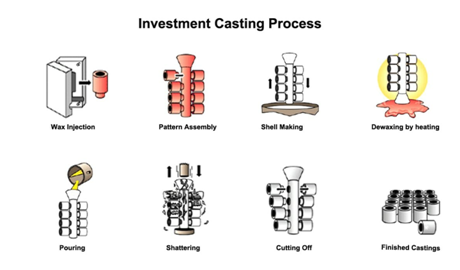
A. Creating the Pattern
It builds a pattern with the same details as the finished part, except that there is an allowance for thermal contraction (i.e. shrinking). Patterns are usually made of wax using a metal injection die.
B. Mounting the wax patterns and creating the tree
Once a wax pattern is produced, it is assembled with other wax components to form the gate and runner metal delivery system. Depending on the size and composition of the finish component, multiple wax patterns may be processed using a single tree.
C. Creating the mold shell
Dipped the entire wax pattern assembly into a ceramic slurry, covered with sand stucco, and allowed to dry. Cycles of wet dipping and consecutive stuccoing are repeated until a shell of the desired thickness is created. That thickness is dictated by product size and composition. Once the ceramic shell has dried, it becomes sufficiently strong to retain the molten metal during casting.
D. Wax removal process
The entire assembly is placed in a steam autoclave to melt away most of the wax.
Any remaining wax that soaked into the ceramic shell is burned out in a furnace. At this point, the residual wax pattern and gating material has been completely removed and the ceramic mold remains with a cavity in the shape of the needed cast part. This high-temperature operation also increases the strength and stability of the ceramic material. In addition, it helps to minimize the reaction of the shell and metal during pouring.
E. Melt and Cast process
Preheat The mold to a specific temperature and form molten metal, creating the metal casting. Nearly any alloy can be produced using this process. Either air melting or vacuum melting, which depends on the alloy chemistry. Vacuum melting is used mainly when reactive elements are present in the alloy.
F. Final operations
Once the casting has cooled sufficiently, the mold shell is broken away from the casting in a knockout operation. The gates and runners are cut from the casting, and if necessary, final post-processing sandblasting, grinding, and machining is performed to finish the casting as per the dimensions.
Advantages of Investment Casting Process
---Excellent surface finish
---High dimensional accuracy
---Extremely complicated parts are castable
---Almost any metal can be cast
---No flash or parting lines
Cutting process
One of the very common types of fabrication is the cutting of a metal work piece to split it into smaller sections. During this process, the metal fabrication company cuts one or more pieces of raw metal for use in the creation of a new metal structure or product. Whether it’s steel, aluminum, iron or any other common type of metal, though, cutting metal requires special tools. Some metal fabrication companies use torches to cut metal, whereas other numerical control (CNC) machines involving lasers or water jets. When finished, the company will have clean, approval-sized sheets or sections of metal with which to work.
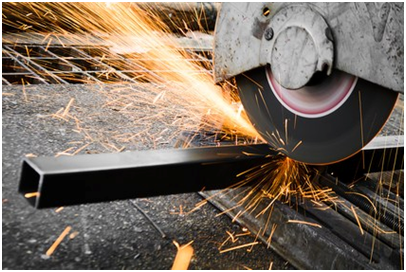
Bending process
After cutting raw metal, we must bend it. Again, there are different ways to bend metal after cutting it. Some metal fabrication companies hammer the metal sheets or sections into the needed shape. Hammering can be done by hand, or it can be done using a machine (power hammering). Recently, though, many metal fabrication companies have begun using bending machines to bend their metal. The heavy industrial machine automatically presses metal sheets and sections into a specific shape when engaged. It essentially clamps the metal between a punch die, forcing the metal into the needed shape.
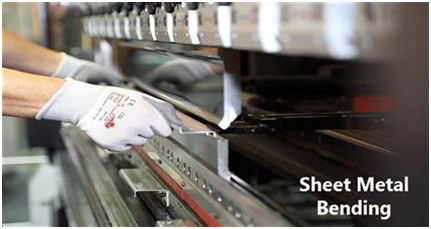
Forging process
Forging uses compressive force to shape metal. A hammer or tool strikes the metal work piece until the needed shape is formed. This process can be done with the metal at room temperature is called cold forging. Forging can also be performed with the metal heated to a range of above room temperature is called hot forging. When the metal is heated to its recrystallization temperature, which varies by metal, the process is called hot forging. Forging is one of the oldest types of fabrication, which has been used centuries ago.
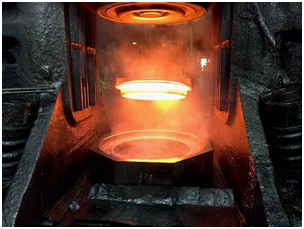
Extrusion process
In the extrusion process, the work piece is forced through or around an open or closed tool, and then the diameter of the work piece is reduced to the cross-section of the tool. When pressed around a tool, a cavity is formed within the work piece. Both of these processes generally use a metal slug or cylinder (a billet) as the work piece, and a ram to perform the impact operation. The resulting cylindrical item product is often wiring or piping. The tool can have different shapes to produce differently shaped parts. Extrusion can be continuous to create very long pieces, or semi-continuous in order to create many shorter pieces.
It is also called cold extrusion, impact extrusion is performed at room temperature and increases the strength of the part, making it stronger than the original material. When enough force is applied to the appropriate metal, it starts to flow into the available shape, much like the movement of viscous liquid. Cold extrusion is commonly used for steel fabrication.
Hot extrusion is in progress at an increased temperature, to keep the metal from hardening and to make it easier to push through the die. It’s usually used for copper fabrication, as well as to create custom aluminum parts.
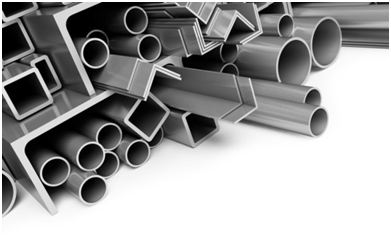
CNC Machining process
Machining means the process of shaping metal by removing the unwanted material from it. This process can be performed in a variety of ways. There are many different machining processes, including drilling, turning, and milling.
Drilling uses a rotary cutting tool, the drill bit, to cut a hole in the material. The drill bit presses against the metal while being rotated very quickly in order to create a circular hole.
Turning uses a lathe to rotate the metal while a cutting tool moves in a linear motion to remove metal along the diameter, creating a cylindrical shape. The cutting tool can be angled differently to create different shapes. It can be done manually or with a CNC turning machine. CNC machining is generally used when part measurements must be extremely high precision.
Milling uses rotating multi-point cutting tools to progressively remove material from the work piece until the desired shape is achieved. The metal is slowly fed into the rotating cutting tool, or the tool is moved across the stationary metal, or both the work piece and the tool are moved in relation to each other. This process can be done manually or with a CNC milling machine. Milling is often a secondary or finishing process, but it can be used as the sole method of fabrication from start to finish. The different types of milling include face milling, plain milling, angular milling, climb milling, and form milling.
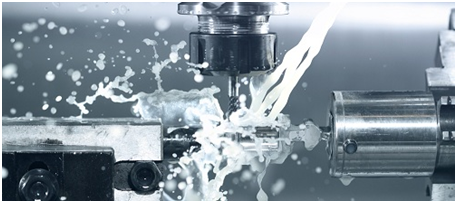
Metal Stamping process
Metal stamping is a manufacturing process used to convert flat metal sheets into specific shapes. It is a complex process that can include a number of metal forming techniques — blanking, punching, bending and piercing, to name a few.
Metal stamping is a fast and cost-effective solution for this large-quantity manufacturing need. Manufacturers who need metal parts stamped for a project generally request three important qualities:
High quality /durability
Low Cost
Fast turnaround time
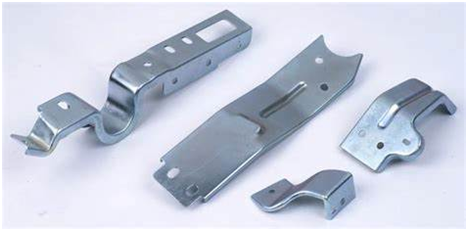
Metal Welding process
Welding is the most economical and efficient way to join metals permanently. It is the only way of joining two or more pieces of metal to make them act as a single piece. Welding is vital to our economy. It is often said that over 50% of the gross national product is related to welding in one way or another. Welding ranks high among industrial processes and involves more sciences and variables than those involved in any other industrial process.
There are many ways to make a weld and many different kinds of welds. Some processes cause sparks and others do not even require extra heat. Welding can be done anywhere — outdoors or indoors, underwater and in outer space.
Nearly everything we use in our daily life is welded or made by equipment that is welded. Welders help build metal products from coffeepots to skyscrapers. They help build space vehicles and millions of other products ranging from oil drilling rigs to automobiles. In construction, welders are virtually rebuilding the world, extending subways, building bridges, and helping to improve the environment by building pollution control devices. The use of welding is practically unlimited. There is no lack of variety of the type of work that is done.
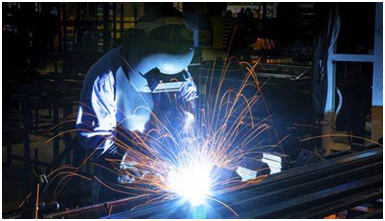
Knowledge 3 Industry characteristics of Metal Fabrication
(1). CNC machining of metal parts
With the rapid development of computer technology, numerical control technology continues to use the technical achievements in the fields of computer and control theory,which makes a high speed, high precision, intelligence, flexibility and information network development. Enterprises can complete the design and processing of products by reading parts drawings, process analysis, manufacturing analysis, CNC programming, program transmission and other steps through CNC technology. The production of products using CNC equipment and technology will have the characteristics of high automation, high precision, stable quality and high production efficiency . Due to the short cycle time and other characteristics, companies in the industry have adopted a large number of CNC technology and made improvements based on their own experience accumulated in their respective industries.
(2). High precision request for metal parts
High precision is a concrete of the increasing requirements of terminal products on structural parts, which can be mainly achieved through high-precision machining technology, which is the result of the combination of high-speed machining technology and CNC technology. Taking auto parts as an example, the processing accuracy of auto parts used to be on the order of 0.01 mm. Now with the increase of precision parts such as computer hard disks and high-precision hydraulic bearings, the precision required for finishing has been increased to 0.1 micron, and the processing accuracy has entered Sub-micron world.
(3). Complexity of metal parts
Enterprises in the precision metal fabrication industry provide metal structure products and services to multiple customers in multiple industries. Faced with the different requirements for the appearance, performance, and structure of metal structure parts in different industries, the combination of CNC machining technology and skilled workers form an organic manufacturing system covering the entire enterprise, so that different products can be produced in the same manufacturing system or the same products can be produced in different production processes. Therefore, the precision metal fabrication industry has complex characteristics.
Knowledge 4 A Look at the Future of metal Fabication
The metal manufacturing industry is highly cyclical and relies on the automotive, aerospace, construction, and energy industries. The automotive industry is the most obvious one. 10 years ago and 20 years ago, there were relatively few cars on the street. Most people used bicycles, electric cars, or transportation as a means of transportation. Basically, there would be no traffic jams. Now that you walk on the street every day, you will see many cars from SUVs to small household cars, there are many different models, and traffic jams have become almost daily conditions. And metal is an important part of the car, from the door to the seat, from the shell to the inside, from the brake to the accelerator, and so on. Economic development is getting better and better, more and more cars, more and more demand for metal manufacturing. When more and more metal manufacturing plants appear, the competition will become more and more fierce, and the factory will find ways to save costs and improve efficiency, strive for more orders and profits for itself, and nowadays, Today, although the global economy is integrated It is getting closer and closer, but the competition is getting fiercer and the industry prices are becoming more transparent. We should improve our technical level to cope with different requirements and changes. We need to seek development opportunities in competition.



